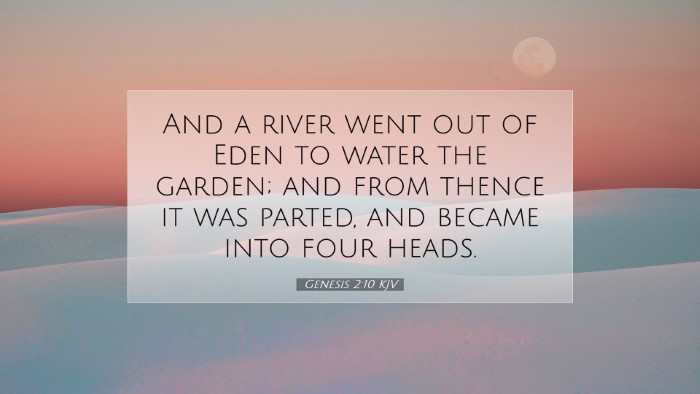Commentary on Genesis 2:10
Genesis 2:10 states:
“And a river went out of Eden to water the garden; and from thence it was parted, and became into four heads.”
Contextual Background
The account of creation in Genesis 1 and 2 is foundational for understanding both the character of God and the nature of humanity. Genesis 2:10 serves as a pivotal verse as it details the arrangement and sustenance of the garden of Eden, which serves as a symbol of divine providence and human dependence on God.
Commentary Insights
Matthew Henry's Insights
Matthew Henry notes that the mention of a river flowing from Eden illustrates the idea of sustenance provided by God. He emphasizes that this river is not just a natural phenomenon, but a divine provision for the garden. The river signifies God’s grace flowing abundantly into His creation, nurturing and sustaining His work:
“The river that went out of Eden adds to the beauty and profusion of the garden, demonstrating God’s merciful provision for all living things.”
Albert Barnes' Perspective
Albert Barnes delves into the geographical and symbolic implications of the river’s division into four heads. He points out that this division indicates a spreading of blessings and resources from the source of life—Eden. Each head represents a different region and culture, illustrating God’s intention for His creation to flourish and diversify:
“The distribution of the river into four heads symbolizes the outpouring of divine grace upon the earth, supporting various peoples and nations.”
Adam Clarke's Commentary
Adam Clarke brings forward an analysis of the names of the four rivers mentioned in Genesis. He connects these rivers to historical and cultural contexts within the ancient Near East. Clarke emphasizes the importance of the hydrological cycle as a metaphor for God’s sustaining nature. The rivers provide not only physical sustenance but also serve as a reminder of the abundant life that flows from God:
“The rivers signify both the actual sustenance provided and the spiritual nourishment that comes from God, demonstrating His role as the source of all life.”
Theological Implications
This verse raises several important theological implications for understanding the nature of God and His relationship with creation:
- Divine Providence: The river symbolizes God’s active involvement in creation, providing for it and ensuring its continued life.
- Interdependence: As the garden thrives by the waters, it illustrates the mutual dependence of creation on its Creator.
- Symbol of Life: Water is often a symbol of life in biblical texts, and here it foreshadows the living water that Jesus speaks of in John 4:14.
- Blessing to Nations: The division into four heads points towards God’s intent to bless all nations, reflecting His universal love and salvific plan.
Practical Applications
For pastors and teachers, Genesis 2:10 offers rich material for preaching and teaching about God’s nature and His provision for humanity. Some practical applications might include:
- Trust in God's Provision: Encourage congregants to trust in God's abundant provision for their spiritual and physical needs.
- Appreciation of Creation: Lead discussions on responsibility towards caring for creation, reflecting God’s stewardship.
- Flow of Grace: Utilize the imagery of the river as a metaphor for God’s grace flowing into their lives, encouraging them to share that grace with others.
- Unity in Diversity: Highlight the significance of different cultures and backgrounds coming together as part of God's diverse creation.
Conclusion
Genesis 2:10 encapsulates profound revelations about God’s nature as the giver of life and sustenance. The imagery of the river flowing from Eden encourages believers to reflect on their own relationship with God as the ultimate source of their spiritual nourishing. The interconnection of natural elements and divine grace in this passage serves as a call to embrace both creation care and the sharing of God’s life with the world. As such, this verse offers a deep reservoir of insight for theologians and scholars to mine for both academic and pastoral enrichment.


